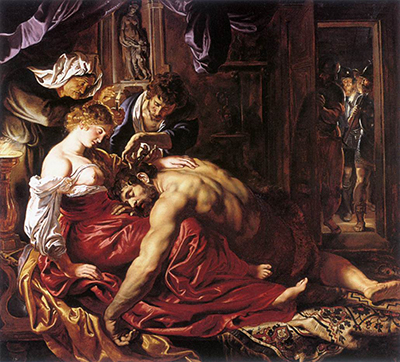Dating from around 1609 to 1610, ‘Samson and Delilah’ is one of Peter Paul Rubens most famous works. The painting illustrates the Old Testament story of Samson and Delilah.
Rubens shows the moment when Samson tells Delilah his strength is from his uncut hair, with Samson asleep on Delilah’s lap as a servant cuts his hair. Soldiers in the right-hand background allude to Samson’s arrest by Philistine soldiers.
Housed in London’s National Gallery, the original oil on wood painting is 185 by 205 centimetres (73 by 81 inches). A similar oil on panel version of ‘Samson and Delilah’ was created in the same period by Rubens. Smaller and less refined, the second version is housed at the Cincinnati Art Museum. It is 50.5 by 52.1 centimetres (19.9 by 20.5 inches) and depicts the same scene with virtually the same details as the larger piece. Rubens also used the biblical story as inspiration for ‘The Death of Samson’, which was created in around 1605, and ‘Samson is Seized’, which was painted in 1609-10.
In the Bible, Samson has great strength that helps him battle his enemies. His feats include killing a lion, using the jawbone of an ass to vanquish an army, and destroying a Philistine temple with his bare hands. Samson falls in love with Delilah, who is paid by the Philistines to find the secret to Samson’s strength. After several attempts to get the truth, Samson tells Delilah the source of his strength is his hair. Once he loses it, he will be weakened. After Delilah’s servants cut Samson’s hair, the warrior is captured and blinded by the Philistines.
Details in ‘Samson and Delilah’ have hidden symbolism linked to biblical story. A niche behind Delilah has a statue of Venus, the Goddess of love. She is accompanied by her son, Cupid. The statue might represent the love and beauty that condemned Samson. Absent from the biblical account but present in Rubens painting is old woman standing behind Delilah. She may symbolise a procuress, potentially referring to Delilah being bought for discovering Samson’s secret. The hands of the servant cutting Samson’s locks are crossed, a sign of deceit.
‘Samson and Delilah’ was commissioned by Nicolaas Rockox, an alderman in Antwerp. The painting was created for the Belgian alderman’s townhouse. The painting boasts elaborate details, particularly the draperies that clothe and surround Delilah. The painting is also notable for the lack of blue pigments. Rubens used lead tin yellow, vermillion, carmine lake from kermes dye, and ochres to create the painting. He also used charcoal black and lead white. Other religious works by Rubens include ‘King Solomon’ (1617), ‘The Fall of the Damned’ (1620), ‘The Virgin of the Immaculate Conception (1626-28), and ‘The Holy Family’ (1630).
Peter Paul Rubens was known for his extravagant Flemish Baroque art work. He was also known for Counter-Reformation portraits, landscapes, altarpieces and other paintings inspired by mythology and allegorical subjects. Rubens’s paintings often displayed stunning scenes of colour with a focus on movement and sensuality. Much of his commissioned work related to religious and mythological subjects as well as hunting scenes. He also created portraits, including self-portraits. His later life focused on landscapes. Rubens was also known for prints and tapestries. The artist was one of the last to use wooden panels for his paintings, like ‘Samson and Delilah’.
Born in 1577 and raised a Catholic, Rubens’s early life was heavily influenced by religion. This early influence likely figured into his Counter-Reformation style. Rubens remarked that the source of his passion was the heavens rather than “early musings”. At fourteen, he started his artistic apprenticeship with leading painters in Antwerp including Tobias Verhaeght, Adam van Noort and Otto van Veen. In 1600, Rubens travelled to Italy and became increasingly inspired by Titian and Caravaggio as well as Michelangelo, Raphael and Leonardo da Vinci.
Rubens returned to Belgium in 1609, where he was appointed as a court painter by the Archduke of Austria Albert VII and Infanta Clara Eugenia. Both monarchs were sovereigns of the Hapsburg Netherlands, which encompassed the Low Countries from 1598 until 1621. Part of his role included diplomatic missions in Europe. During this time, Rubens’s reputation grew and he created some of his most famous works such as the ‘Assumption of the Virgin Mary’ for the Cathedral of Antwerp. Rubens’s most well-known work include nudes of biblical and mythological women as well as full-figured women. A yearning gaze from male subjects is another trademark of his paintings. Rubens died in 1640 in Antwerp.




